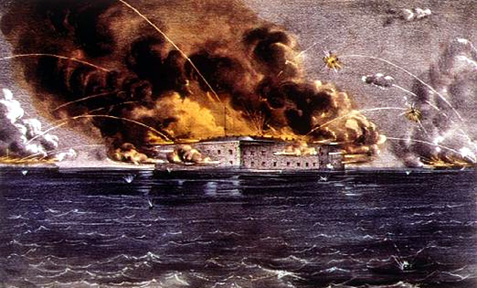April 12, 1861: Battle of Fort Sumter, the Civil War Begins
In November 1860, Abraham Lincoln was elected President of the United States. Shortly after, South Carolina became the first state to secede, doing so on December 20, 1860. Mississippi and Florida followed, with Alabama, Georgia, Louisiana and Texas joining them. On April 12, 1861, the Civil War officially began at the Battle of Fort Sumter.
The South Carolina militia bombarded Fort Sumter, an island fortification near Charleston, South Carolina. The Confederate Army had not yet officially formed. The attack began in the early morning hours of April 12, 1861, when Lieutenant Henry S. Farley fired a mortar round over Fort Sumter as a signal to the militia to begin firing on Fort Sumter. The militia, led by General P.G.T. Beauregard, had the upper hand. The Fort, led by Major Robert Anderson, had been designed and fortified to respond to, and defend against, naval attack, but over the ensuing battle proved to be no match for land bombardment.
Fort Sumter had a total of 60 guns but many of them were on top, where Anderson’s troops would be most vulnerable to being hit by incoming fire from the militia. The twenty-one guns on the lower level did not allow the trajectory needed to hit any of the artillery of the attackers. Anderson and his troops did what they could, engaging in an exchange of fire that lasted for thirty-four hours. Because efforts by President Lincoln to resupply Fort Sumter had not been successful, and despite moving as many supplies to the fort as possible, Anderson and his troops were short on ammunition. They reduced the number of guns being deployed.
The militia began to fire heated shots at the fort, hitting some of the wooden structures within. Fires ensued, but on April 12th, a rain shower put those fires out. On April 13th, the heated shot barrage would resume and do substantial damage to the fort.
Early in the morning of April 13, 1861, Gustavus V. Fox arrived, leading the supply relief expedition that President Lincoln had ordered. But his arrival would do little to change the equation. Around 1 PM on April 13, the central flagpole was knocked down. Colonel Louis Wigfall, an aide to Beauregard, without authorization rowed a skiff to the island fort and met with Anderson. He is reported to have said, “You have defended your flag nobly, Sir. You have done all that it is possible to do, and General Beauregard wants to stop this fight. On what terms, Major Anderson, will you evacuate this fort?”
Anderson agreed to a truce, proud of his troops and not having lost any of his men to the bombardment. After Beauregard’s initial contingent disavowed Wigfall’s settlement terms, Beauregard saw the surrender handkerchief and sent a second contingent, which offered similar terms to what Wigfall had. With that, Anderson surrendered, and the South had won its first battle. Over the next almost four years, the Confederate troops would hold Fort Sumter, withstanding several Union army attacks.
The Battle of Fort Sumter caused many Northerners to strongly advocate for the assembly of volunteer troops to recapture the fort and to preserve our Union. The war would go on for four years, with approximately 750,000 casualties.
Dan Cotter is Attorney and Counselor at Howard & Howard Attorneys PLLC. He is the author of The Chief Justices, (published April 2019, Twelve Tables Press). He is also a past president of The Chicago Bar Association. The article contains his opinions and is not to be attributed to anyone else.
Click Here to have the NEWEST essay in this study emailed to your inbox every day!
Click Here to view the schedule of topics in our 90-Day Study on American History.




Join the discussion! Post your comments below.
Your feedback and insights are welcome.Feel free to contribute!